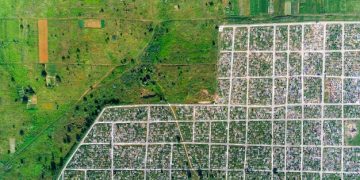Sustainable Fashion: Eco-Friendly Wardrobe for Planet & Wallet

Sustainable fashion is an approach to clothing production and consumption that minimizes environmental impact, respects labor rights, and encourages a circular economy, allowing consumers to build an ethical wardrobe while often saving money in the long run.
Embarking on the journey of building a Sustainable Fashion: Build a Wardrobe That’s Good for the Planet and Your Wallet may seem like a daunting task at first, but it’s a transformative endeavor that benefits both your personal finances and the health of our Earth. This shift in mindset from fast fashion to thoughtful consumption is not merely a trend; it’s a vital movement towards a more conscious way of living.
Understanding the Impact of Fast Fashion
The fashion industry, particularly its fast fashion segment, has long been a significant contributor to environmental degradation and social injustice. Its model relies on rapid production cycles, aiming to quickly turn trends into affordable, disposable garments. This constant churn creates a massive strain on natural resources and generates an astonishing amount of waste.
The environmental footprint of fast fashion is immense, touching every facet of the production chain. From the cultivation of resource-intensive crops like cotton, which often demands vast quantities of water and pesticides, to the dyeing and finishing processes that release toxic chemicals into waterways, the ecological damage is widespread. The manufacturing phase also involves significant energy consumption, frequently derived from fossil fuels, contributing to greenhouse gas emissions.
Water Pollution and Usage
The thirst of the fashion industry is insatiable, particularly for water. Cotton, a primary material, is one of the most water-intensive crops globally.
- Cultivation: Growing just one kilogram of cotton can require thousands of liters of water.
- Dyeing: The vibrant colors we see in fast fashion are often achieved through chemical dyes that contaminate water sources if not properly treated.
- Washing: Even after purchase, the consumer phase adds to water usage through frequent washing cycles.
These practices lead to water scarcity in already arid regions and pollute vital freshwater ecosystems, impacting biodiversity and human health.
Beyond water, the issue of microplastic pollution from synthetic fabrics like polyester and nylon is increasingly alarming. Each wash of these garments releases tiny plastic fibers into our oceans and rivers, entering the food chain and posing a long-term threat to marine life and potentially human health. The sheer volume of clothing produced also contributes to enormous landfill waste, where non-biodegradable materials can take hundreds of years to decompose. Understanding these complex impacts is the first step towards embracing a more sustainable approach to fashion, enabling consumers to make informed choices that mitigate harm.
The Core Principles of Sustainable Fashion
Sustainable fashion is more than just a buzzword; it’s a movement rooted in a set of core principles designed to minimize the environmental and social impact of the clothing industry. This approach considers the entire lifecycle of a garment, from its raw materials to its disposal, advocating for practices that are equitable, ecological, and enduring. It challenges the conventional linear model of “take, make, dispose,” promoting a circular economy where resources are reused and recycled.
One of the fundamental principles is the emphasis on ethical production. This includes ensuring fair wages, safe working conditions, and respect for human rights throughout the supply chain. This means moving away from exploitative labor practices, often hidden deep within complex global manufacturing networks, and advocating for transparency and accountability. Brands committed to ethical production often seek certifications or partner with organizations that audit their labor practices.
Prioritizing Durability and Quality
A cornerstone of sustainable fashion is the deliberate shift towards purchasing high-quality, durable garments. This contrasts sharply with fast fashion’s emphasis on disposability.
- Longevity: Investing in well-made pieces that are designed to last reduces the need for frequent replacements.
- Material Choices: Opting for natural, organic, or recycled materials that stand the test of time.
- Craftsmanship: Supporting brands that prioritize skilled craftsmanship and ethical manufacturing processes.
By doing so, consumers can extend the lifespan of their clothing, reducing landfill waste and conserving resources.
Finally, conscious consumption forms the bedrock of sustainable fashion. This principle encourages thoughtful purchasing decisions, urging individuals to buy less, choose well, and make those items last. It promotes an understanding of the true cost of clothing, beyond the price tag, encompassing environmental degradation and social exploitation. Embracing sustainable practices fosters a deeper connection to our clothes and a greater appreciation for the resources and labor involved in their creation.
Building a Sustainable Wardrobe: Starting Small
Embarking on the journey to build a sustainable wardrobe doesn’t require an immediate overhaul; it’s a gradual process of mindful choices and conscious consumption. The most effective way to begin is by starting small, focusing on incremental changes that can collectively make a significant impact. This approach allows for a more manageable transition, both financially and practically, embedding sustainable habits into your lifestyle one step at a time. The initial phase often involves a careful assessment of your current wardrobe and a shift in perspective towards how you view clothing.
One of the first practical steps is to implement a “wardrobe audit.” This involves going through your existing clothes to understand what you already own, what you truly wear, and what might be missing. This process can reveal surprising insights into your personal style, highlight redundant purchases, and identify items that can be repaired, repurposed, or donated. It’s an opportunity to embrace the philosophy of “use what you have” before acquiring anything new.
The Power of Secondhand and Vintage
Diving into the world of secondhand and vintage shopping is perhaps one of the most accessible and impactful ways to start building a sustainable wardrobe.
- Thrift Stores: Explore local thrift shops for unique finds at affordable prices.
- Consignment Boutiques: Discover higher-end pre-owned items in excellent condition.
- Online Marketplaces: Utilize platforms dedicated to selling used clothing, expanding your options.
This practice extends the life cycle of garments, reduces demand for new production, and keeps clothing out of landfills. It’s a treasure hunt that also benefits the planet and your wallet.
Furthermore, consider the concept of “cost per wear” when making new purchases. Instead of focusing solely on the price tag, evaluate how often you anticipate wearing an item. A seemingly expensive, high-quality garment that you wear frequently across many seasons can be more sustainable and cost-effective in the long run than several cheap, trendy pieces that quickly fall apart or go out of style. This mindset encourages investment in durable, timeless pieces that serve you well for years, gradually forming the core of a truly sustainable wardrobe.
Investing in Quality and Durability
In the realm of sustainable fashion, the adage “buy less, choose well, make it last” truly encapsulates the essence of mindful consumption. Investing in quality and durability is not just about purchasing expensive items; it’s about making thoughtful choices that prioritize longevity, ethical production, and timeless design over fleeting trends and disposable fashion. This approach challenges the fast fashion model directly, offering a pathway to build a wardrobe that serves you for years, thereby reducing waste and conserving resources.
The initial outlay for a high-quality garment might be higher than its fast-fashion counterpart, but the long-term economic and environmental benefits are substantial. Durable clothing is designed to withstand repeated wear and washing, meaning you won’t need to replace items as frequently. This not only saves you money over time but also significantly reduces your contribution to landfill waste and the demand for new production, which consumes vast amounts of energy and raw materials.
Identifying High-Quality Garments
Knowing how to spot quality is key when making sustainable fashion choices. Look beyond brand names and consider the following aspects:
- Fabric Composition: Prioritize natural fibers like organic cotton, linen, hemp, or sustainable alternatives like Tencel and Modal. For synthetics, look for recycled options.
- Construction and Stitching: Examine the seams for neatness and strength. Double stitching, reinforced buttonholes, and well-aligned patterns are indicators of good craftsmanship.
- Hardware and Zippers: Good quality zippers and sturdy buttons or clasps are less likely to break, extending the garment’s life.
These details often signify a brand’s commitment to durability and a garment’s potential for a longer lifespan.
Furthermore, investing in quality often means supporting brands that adhere to ethical manufacturing practices. These companies typically pay fair wages, ensure safe working conditions, and minimize their environmental footprint. By choosing such brands, you are not only acquiring a long-lasting product but also contributing to a more equitable and sustainable industry. This holistic approach ensures that your wardrobe not only looks good but also does good for both people and the planet, demonstrating that truly sustainable fashion is an investment in our collective future.
The Role of Material Choices in Sustainable Fashion
The materials used in clothing production are at the very heart of sustainable fashion, directly influencing a garment’s environmental footprint from cultivation or creation to disposal. Making informed material choices is a crucial step in building a more eco-conscious wardrobe, as different fibers carry vastly different impacts on water use, chemical pollution, energy consumption, and biodegradability. Understanding these distinctions empowers consumers to select garments that align with their environmental values, thereby driving demand for more responsible sourcing and manufacturing practices across the industry.
Natural fibers often present a more sustainable option, although their cultivation can still carry significant environmental costs. For instance, conventional cotton is notoriously water-intensive and often relies heavily on pesticides. However, alternatives like organic cotton significantly reduce these impacts by avoiding synthetic chemicals and promoting healthier soil. Similarly, linen and hemp are celebrated for their minimal water requirements and natural resilience, making them excellent choices for durable, sustainable clothing.
Emerging Sustainable Materials
Innovation in textile production is continuously yielding new and improved materials that offer exciting sustainable options.
- Recycled Polyester (rPET): Made from recycled plastic bottles, it diverts waste from landfills and oceans and requires less energy than virgin polyester.
- Tencel™ Lyocell: A remarkably sustainable fiber derived from sustainably sourced wood pulp, produced in a closed-loop system that recycles water and solvents.
- Pinatex™: An innovative, leather-alternative textile made from cellulose fibers extracted from pineapple leaves, a byproduct of existing agriculture.
These materials represent a significant step forward in reducing the environmental footprint of fashion, offering high performance with lower impact.
Conversely, some synthetic fibers, while durable, pose challenges associated with their petroleum-based origins and microplastic shedding. However, advancements in recycling technologies, particularly for materials like polyester, are helping to mitigate some of these concerns. Ultimately, the most sustainable material choice often depends on a balance of factors, including its origin, the manufacturing process, and its end-of-life possibilities. By prioritizing materials that are responsibly sourced, require fewer resources, and are designed for longevity or circularity, consumers can truly embody the principles of sustainable fashion and contribute to a healthier planet.
Caring for Your Sustainable Wardrobe
Building a sustainable wardrobe is only one half of the equation; the other, equally critical half, involves responsibly caring for your clothes. The choices made in garment care—from washing methods to storage—have a profound impact on a garment’s lifespan, its environmental footprint, and ultimately, the sustainability of your entire wardrobe. Proper care extends the life of your apparel, reducing the need for frequent replacements and minimizing the resources consumed in the entire lifecycle of clothing. This diligent approach to maintenance is a practical and effective way to reinforce your commitment to eco-conscious living.
The most basic yet often overlooked aspect of garment care is simply washing less frequently. Many garments, especially outerwear or items worn for short periods, do not require washing after every wear. Spot cleaning, airing out clothes, or steaming them can often refresh items without the need for a full wash cycle, saving water, energy, and reducing wear and tear on fabrics. Over-washing is a significant contributor to fabric degradation, leading to colors fading, fibers weakening, and garments losing their shape prematurely.
Mindful Washing Practices
When washing is necessary, adopting mindful practices can drastically reduce environmental impact.
- Use Cold Water: Washing in cold water significantly reduces energy consumption, as heating water for laundry requires substantial electricity or gas.
- Full Loads: Always wait until you have a full load of laundry to maximize efficiency and minimize water and energy waste per item.
- Gentle Detergents: Opt for eco-friendly, biodegradable detergents free of harsh chemicals, which can pollute waterways.
These small adjustments in your laundry routine can lead to substantial savings in resources and a longer life for your clothes.
Furthermore, consider the drying process. Air drying clothes whenever possible is the most energy-efficient option and gentler on fabrics compared to machine drying, which can cause shrinkage and damage over time. For items that require ironing, use the lowest effective heat setting and iron in batches to conserve energy. Finally, mending and repairing clothes should be a natural part of garment care. Learning basic sewing skills to fix a loose button, patch a small hole, or re-hem a garment can breathe new life into beloved pieces, rather than discarding them prematurely. This approach transforms clothes from disposable items into valued possessions, embodying the true spirit of a sustainable wardrobe.
The Financial Benefits of Sustainable Fashion
While the initial perception of sustainable fashion might suggest higher costs, a deeper analysis reveals significant financial benefits over the long term. Shifting to thoughtful consumption and investing in quality pieces can surprisingly lead to considerable savings, making a sustainable wardrobe not just good for the planet but also for your wallet. This financial prudence emerges from a fundamental change in purchasing habits and a reduced need for frequent replacements, directly countering the built-in obsolescence of fast fashion.
The primary financial advantage stems from the “cost per wear” principle. Although a well-made, sustainable garment may have a higher upfront price, its durability means it will endure many more wears than a cheaper, lower-quality item. Over its extended lifespan, the cost per wear of the sustainable piece drastically diminishes, often making it more economical than repeatedly buying and replacing fast fashion items that quickly fall apart or go out of style. This long-term value outweighs the initial investment.
Reduced Impulse Buying and Wardrobe Efficiency
Embracing sustainable fashion naturally leads to a more deliberate and less impulsive approach to shopping.
- Mindful Spending: Focusing on quality and need rather than fleeting trends reduces unnecessary purchases.
- Curated Wardrobe: A smaller, more versatile wardrobe of cherished pieces simplifies dressing and minimizes redundant items.
- Repair and Reuse: Prioritizing mending, altering, and repurposing extends the life of existing garments, delaying new acquisitions.
This conscious mindset helps individuals avoid the trap of constant consumerism, freeing up funds for other priorities.
Furthermore, the growing popularity of secondhand markets, rental services, and clothing swaps offers affordable avenues to build a diverse and stylish wardrobe without contributing to new production. Thrift stores, consignment shops, and online platforms provide access to high-quality items at a fraction of their original price, allowing consumers to stretch their budget significantly. By integrating these practices, consumers can enjoy fashion freedom while adhering to financial discipline. Thus, sustainable fashion is not merely an ethical choice but a financially savvy strategy that proves economically smart in the long run, redefining value beyond the initial price tag.
| Key Point | Brief Description |
|---|---|
| 🔄 Circular Economy | Focuses on reusing, recycling, and repairing garments to minimize waste and resource consumption. |
| 🌱 Ethical Sourcing | Prioritizes fair wages, safe conditions, and sustainable practices throughout the supply chain. |
| 💰 Wallet-Friendly | Long-term savings through durability, reduced impulse buying, and exploring secondhand options. |
| 💧 Eco-Care | Washing less, using cold water, and air drying extend garment life and conserve resources. |
Frequently Asked Questions About Sustainable Fashion
▼
Sustainable fashion is a movement and process of fostering change to fashion products and the fashion system towards greater ecological integrity and social justice. It considers the entire product lifecycle and aims to reduce environmental impact and improve social conditions in production.
▼
Fast fashion contributes to environmental harm through excessive water consumption, chemical pollution from dyes and treatments, significant greenhouse gas emissions during production, and massive textile waste in landfills. It also leads to microplastic pollution from synthetic fibers.
▼
Key practices include buying less, choosing high-quality, durable garments, exploring secondhand and vintage options, opting for sustainable materials, and properly caring for your clothes to extend their lifespan. Prioritizing ethical brands and local production also helps.
▼
While some sustainable items may have a higher upfront cost due to quality materials and ethical labor, they often prove more cost-effective in the long run. Their durability means less frequent replacement, and buying secondhand reduces expenses significantly, offering financial benefits over time.
▼
Care for your sustainable clothes by washing them less frequently, using cold water and eco-friendly detergents, air drying instead of machine drying, and mending simple repairs. Proper care extends their lifespan, maintaining their quality and reducing your environmental footprint.
Conclusion
Embracing sustainable fashion represents a thoughtful and impactful shift in how we approach our clothing choices, moving beyond fleeting trends to a more considered and responsible consumption. It’s a journey that benefits not only the planet by reducing environmental degradation and waste but also our personal finances through savvy investments in quality and mindful purchasing. By understanding the true cost of our clothes and actively engaging in practices like extended use, responsible care, and supporting ethical production, we collectively contribute to a healthier, more equitable future for both our wardrobes and our world.





